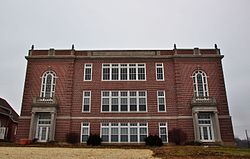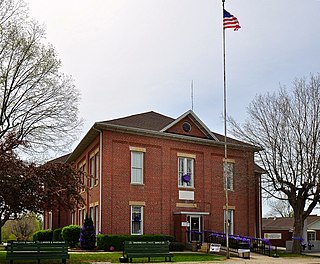
Bollinger County is a county located in the southeastern part of the U.S. state of Missouri. As of the 2020 census, the county's population was 10,567. The county seat is Marble Hill. The county was officially organized in 1851.

The Bollinger Mill State Historic Site is a state-owned property preserving a mill and covered bridge that pre-date the American Civil War in Burfordville, Cape Girardeau County, Missouri. The park was established in 1967 and offers mill tours and picnicking. It is managed by the Missouri Department of Natural Resources. It includes the Burfordville Covered Bridge, which is listed on the National Register of Historic Places.
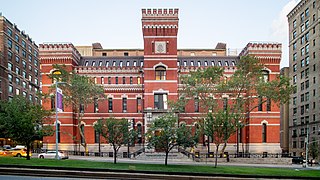
The Seventh Regiment Armory, also known as Park Avenue Armory, is a historic National Guard armory building located at 643 Park Avenue in the Upper East Side neighborhood of Manhattan, New York City. The building is a brick and stone structure built in 1880 and designed in the Gothic Revival style by Charles Clinton.

Downtown Columbia is the central business, government, and social core of Columbia, Missouri and the Columbia Metropolitan Area. Three colleges — the University of Missouri, Stephens College, and Columbia College — all border the area. Downtown Columbia is an area of approximately one square mile surrounded by the University of Missouri on the south, Stephens College to the east, and Columbia College on the north. The area serves as Columbia's financial and business district and is the topic of a large initiative to draw tourism, which includes plans to capitalize on the area's historic architecture and Bohemian characteristics. The downtown skyline is relatively low and is dominated by the 10-story Tiger Hotel, built in 1928, and the 15-story Paquin Tower.
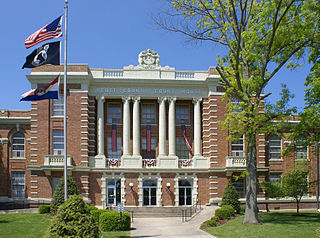
Scott County Courthouse is a historic courthouse located at Benton, Scott County, Missouri. It was designed by architect Henry H. Hohenschild and built in 1912. It is a reinforced concrete Beaux Arts style building sheathed in brick. It has a "T"-plan consisting of a three-story, five bay, central block with two-story wings. Three bays of the central block are recessed behind colossal Ionic order columns that support a dentiled entablature. It features terra cotta and cast stone ornamentation.
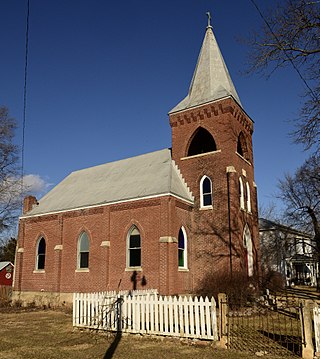
Zion Lutheran Church is a historic Lutheran church located near Jefferson City, Cole County, Missouri. It was built in 1906, and is a one-story Gothic Revival building constructed of brick with a limestone foundation. It features a three-story front tower with a spire and a polygonal apse in the rear.

The Second Baptist Church, also known as Pleasant Hill Baptist Church, is a historic African-American Baptist church located at Neosho, Newton County, Missouri. It was built in 1896, and is a one-story, rectangular brick building with Gothic Revival style design elements. It sits on a stone foundation, has a gable roof, and features a projecting, centered, two-story brick belfry.

Mount Zion Church and Cemetery is a historic church and cemetery located east of Hallsville in Boone County, Missouri. The Gothic Revival style frame church was built in 1903. It was the location of the Battle of Mount Zion Church during the American Civil War. The cemetery contains over seven hundred grave sites, including many American Civil War soldiers. The grounds contain a memorial to the Missouri State Guard. The church is still functioning today.

'Rankin Hall, also known as the Administration Building and Chapel of Tarkio College is a historic building located on the campus of the former Tarkio College at Tarkio, Atchison County, Missouri. It was built in 1930–1931, and is a 3 1/2-story, "T"-shaped, Collegiate Gothic style brick and stone building. The building measures 144 feet wide and extends 141 feet deep. It features steep projecting gables with stepped parapets, numerous pointed arch windows, buttresses, and a mix of limestone and cast stone trim. The building served as the Presbyterian college's administration building and chapel.

Court Street Historic Residential District is a national historic district located at Fulton, Callaway County, Missouri. It encompasses 84 contributing buildings in a predominantly residential section of Fulton. It developed between about 1844 and 1945, and includes representative examples of Queen Anne, Second Empire, Colonial Revival, American Foursquare, and Bungalow style architecture. Some of the buildings were designed by noted local architect Morris Frederick Bell. Located in the district is the separately listed Brandon-Bell-Collier House. Other notable buildings include the John W. Tucker Residence (1912), Klinginsmith Residence, Synodical College-Seminole Apartments, Synodical College Dormitory-Seminole Apartments (1913), Gish Residence, Dave and Ida McCue House, First Presbyterian Church, Leland Waters Residence, Bauer House, and Martin-Harris House.
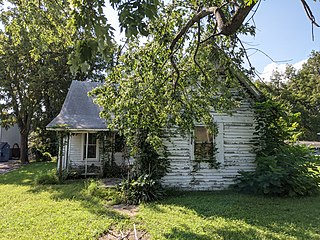
Charles and Bettie Birthright House is a historic home located at Clarkton, Dunklin County, Missouri. It was built in 1872, and began as a double pen, side gable home with full width porch. A 1+1⁄2-story front addition about 1914 added a prominent front gable wing. It sits on a brick and concrete foundation.
Assumption of the Blessed Virgin Mary Parish Historic District, also known as Cedron Church and Assumption Catholic Church, is a historic Roman Catholic church complex and national historic district located at the Cedron settlement near Jamestown, Moniteau County, Missouri. The church was built between 1867 and 1872 and is a brick gable-end church. A three-tiered brick bell tower and sacristy were added in 1903. Also on the property are the contributing school, rectory (1908), privy, and cemetery. The cemetery contains approximately 285 graves with the earliest dating from November 1841.

Farmers Mercantile Co. Building is a historic commercial building located at High Hill, Montgomery County, Missouri. It was built in 1904, and is two-story, frame building. It rests on a stone foundation and has a low-pitched gable roof behind a stepped parapet. The building historically served as a social and commercial center for the community.
Delmo Community Center, also known as South Wardell Utility Building, is a historic community centre located at Homestown, Pemiscot County, Missouri. It was designed and constructed by the Farm Security Administration in 1940 as a utility building for the entire community. It is a long one-story, rectangular, frame building on a concrete foundation. It measures approximately 56 feet by 26 feet and is sheathed in clapboard siding.
Henry Jones Farmstead is a historic home and farm located near Sedalia, Pettis County, Missouri. The farmhouse was built in 1878, and is a two-story, Italianate style brick dwelling. It has a Georgian plan, a portico with balustraded deck, and low hipped roof topped by a widow's walk. Attached is a summer kitchen that was constructed in 1885. Also on the property are the contributing frame gable roof tenant cottage, a buggy house, and a transverse crib barn (1892).
Community Theater, also known as the Lyric Theater, Newburg Theater, and Regional Opera Company, is a historic theatre building located at Newburg, Phelps County, Missouri. It was built in 1919, and is a one-story, rectangular brick building. It has a front gable roof behind a stepped parapet and segmental arched windows flanking the rounded arched central entrance. Until 1955, the building acted as a movie theater, lecture hall and stage for small plays and community events. More recently, the building has seen a rebirth as a theater for small stage productions.

Frederick Krause Mini Mansion, also known as the Ben Ferrel Platte County Museum, is a historic mansion located at Platte City, Platte County, Missouri. It was built in 1882-1883 by Frederic Krause, an immigrant from Prussia. The mini mansion is a two-story, modified "T"-plan, Second Empire style red brick building with limestone corner quoins and foundation. It is topped by a mansard roof with gray-blue and rose hexagonal slate. The roof and porches are crested with ornamental cast iron work. The home is referred to as a 'mini' mansion because it shares several architectural features with the Missouri Governor's Mansion built in 1871. An interior, bronze fireplace surround also represents similar design to the white marble one found in the Governor's Mansion in Jefferson City. The Krause mini mansion houses the Ben Ferrel Museum and genealogical and historical research room for the Platte County Historical Society known by the acronym PCHS. The Platte County Historical Society owns and operates the building which opened to the public in 1985. The museum's collection presents regional history with furnishings and items donated entirely from local families and dating mainly from the mid-1800s to 1920. The museum features exhibits and other special events related to local history and the mini mansion's history.
North Ward School, also known as the Bolivar High School and Polk County North Ward Museum, is a historic school building located at Bolivar, Polk County, Missouri. It was designed by architect Henry H. Hohenschild and built in 1903. It was listed on the National Register of Historic Places in 2011.
Farmington State Hospital No. 4 Cemetery is a historic cemetery located near Farmington, St. Francois County, Missouri. It was established in 1903, and is a rectangular plot measuring 180 feet by 450 feet. The cemetery is divided into 24 sections each containing 50 graves marked by simple wooden crosses. The entrance is marked by two concrete pillars molded to look like stylized columns. The cemetery was established as the burial ground for Missouri State Hospital #4.
Houston High School is a public high school serving Houston, Texas County, Missouri. It is operated by the Houston R-I School District. The high school building is a registered historic site.
